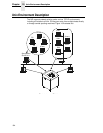
Windows 3.1 Host Setup
187
Windows 3.1 Host Setup
If you are running Windows 3.1 stations on your network, you will need to rely
on either TCP/IP or IPX to print to the NIC. If IPX is used, you will have a print
queue defined on a Novell file server to which your Windows 3.1 stations will
send their print jobs. The NIC will then service this print queue as either a
PSERVER or an RPRINTER. Please see Chapter 11, “Novell Configuration”
for additional details.
If you want to rely on TCP/IP, you will need a third party TCP stack loaded
onto your Windows station since TCP/IP support did not automatically come
with Windows until the introduction of Windows NT and Windows 95. You
may also be running a third party stack if you decided not to use a Microsoft
operating system.
Some common TCP stacks are FTP Software's
OnNet, NetManager's
Chameleon, and Frontier Technologies'
SuperTCP. In each case, they allow
your Windows 3.1 station to communicate with other TCP/IP devices. This
means you can send print jobs to the NIC as well.
The most common print method offered with Windows TCP stacks is LPR/
LPD, a multi-platform remote printing protocol used on everything from PCs to
mainframes. The LPR print setup is very simplistic, involving only two
parameters:
1. NIC IP address. The IP address or host name of the print server you
want to print to.
2. NIC destination/queue. A pre-defined name on the print server telling
the device which I/O port to send the jobs to. The standard name for the
PRN port is d1prn. This destination name is case sensitive, and, by
default, all names are lowercase.
Windows Troubleshooting Tips
This section provides information on possible solutions to some standard
configuration errors. If you require technical support, please have as much of
the following information as you can available when you call:
1. What level of software are you running?
2. What type of attachment do you have?
3. What is your host operating system?
4. Give a detailed description of the problem.
5. How often, and when, does the problem occur?
6. Give a detailed description of your network and the components attached.
Please follow these tips to determine what the problem may be with your NIC
configuration.


















